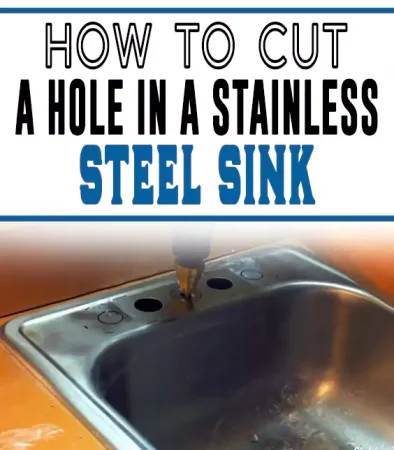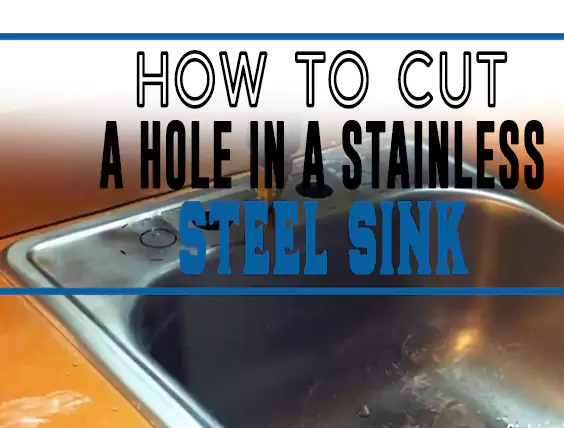You might be asking how to cut a hole in a stainless steel sink without causing any scratches or damage. Here’s how to do it.
Some of the best stainless steel kitchen sinks come with a pre-drilled hole for faucet installation, some don’t come.
Recently, I had to cut a 1 1/2 inch hole in my new 18 gauge stainless steel sink’s deck. The sinks had three predrilled holes. I needed another hole for installing a soap dispenser. I’ve done the job perfectly with the help of a “Starret” hole saw.
Making a perfect hole in a stainless steel sink or enlarging the existing holes should be easier. To prevent damage, you may consider the following methods for cutting holes in a stainless steel sink.

Can You Cut A Hole In Stainless Steel Kitchen Sink?
Yes, you can cut holes through stainless steel. To cut a new hole use a hole saw. The hole saw will work fine. It will go straight through the stainless sink and leave a smooth hole with no damage or scratch.
I would hold my drill with one hand, and my can of WD40 in the other. When I kept it lubricated, the saw cut was wonderful. I kept the RPM about 200 and used a big drill with lots of power at low RPM.
Tip: Use cutting oil frequently. This will keep the heat down, and prevent the bluing of the stainless steel metal.
How to Cut a Hole in a Stainless Steel Sink
Step 1: Collect the Tools and Materials
Look for the following items and place them in an ideal place ready for use;
- Hole Saw
- Drill Bit
- Sandpaper for fine grains
- A sharp-pointed tool or object like a nail
- Measuring stick or tape measure
- Kitchen sinkhole punch
- Lubricating oil
- Marker
- Gloves
- Safety goggles
- Apron
- Soft brush
- Vacuum machine
- Air blower
Step 2: Put on Safety and Protection Gear
While dealing with small machines and sharp tools, accidents are bound to happen. It is wise to protect your hands and eyes from any harm.
Put on your goggles and gloves. You could soil your clothes.
Therefore, it’s essential to put on an apron that will cover your clothes from direct contact with any form of dirt while carrying out the procedure.
Step 3: Prepare the Sink for Hole Cutting
After protecting yourself, it’s time to ensure that the sink is ready for hole cutting. Start by removing everything inside and around it, such as utensils or personal hygiene products. Also, ensure that it’s clean and dry.
If you installing the sink for the first time, it’s advisable to cut the hole before fixing it. Also, you may need to remove an installed sink first to drill the hole. It depends on where you want to cut the hole.
Step 4: Locate the Cutting Spot
When your sink is ready for cutting, identify the cutting spot. It would be best to be sure of the cutting location because you cannot undo it once done.
While deciding on the cutting location, you need to have some things on your mind. Consider the hole’s distance from the pipes. Also, think of any potential damages. Survey the sink to ensure the cutting spot you’ve chosen is okay.
If installing a fixture, the correct hole location would be where you want it to be. Then mark the area using masking tape.
Step 5: Indentation at the Cutting Spot
Drills are known to skip from the target location while in use. To avoid this on your stainless steel, you should first make an indentation. You can use a nail or any other sharp tool.
Make a small dent or divot in the middle of the hole location by hammering the nail or sharp tool.
The indentation made will act as a guide to the drill when you start cutting. The drill will not sway away and damage the surface of your sink.
Step 6: Oil the Drill Bit
Drill bits are of many types and meet various drilling problems. You need to choose the right one for cutting stainless steel. Then ensure it’s maximally lubricated using the correct oil. Otherwise, the drilled hole will have rough edges.
Apply the lubricant using a rag or paper towel to avoid over-lubrication or messing up your working area with spilled oil.
Smoke may appear while cutting. It means that heat has gotten generated. You must stop cutting as soon as you see smoke.
Step 7: Start the Cutting Process
During cutting, tiny particles may fly into your eyes. Ensure your goggles or eye protective gear are appropriately worn.
Then place the drill bit’s point on the indentation. The masking tape around the hole location will help the drill bit achieve high precision during the process.
While on the indentation, hold the drill bit vertically and start drilling. The drilling speed should be low to help catch a clear glimpse of the cutting process.
Also, move the drill bit toward your dominant hand’s direction. For example, if you are left-handed, let the drill move anticlockwise. If right-handed, direct it clockwise.
Stop cutting the hole when the drill bit penetrates your sink surface.
Step 8: Measure the Hole
After you stop cutting, you need to determine if you’ve achieved the hole size you want. When you drill a bigger hole than expected, you will have messed up because there’s no way to make it smaller. You, therefore, need to be careful when cutting.
That’s why you need to stop cutting every minute and check the size by measuring the sink drain size. Stop cutting when you achieve the correct hole size.
The hole’s purpose will guide you on its size. You only need to ensure it matches the size of the drain assembly, faucet, or other fixture that you want to install.
After achieving the right size, ensure the hole is perfectly round. Otherwise, it may cause some leakage when you start operating the fixture.
Step 9: Smoothen the Hole
A drilled hole contains some sharp edges. When you finish confirming the size and roundness of the hole, you need to get rid of the sharp edges.
Start by cleaning debris and other dirt caused by the cutting process from the surface. Use a paper towel. Then use emery cloth or fine grain sandpaper to smoothen the rough edges.
Ensure you have put on the correct protective gloves as the sharp edges can cut your sink.
To make the stainless steel sink more user-friendly and reliable, you may need to drill one or several holes in it.
How to Enlarge an Existing Hole in Stainless Steel Sink
Enlarging an existing hole in a stainless steel sink may sound easy but can be a challenge. Fortunately, the following step-by-step guide will show you how to do it easily.
Step 1: Accumulate the Required Items
Like cutting a hole in a stainless steel sink procedure detailed above, you require the correct tools and items. You will need the following;
- Step drill bit – titanium coated
- Rotary tool kit
- Marker
- Sandpaper
Step 2: Measure and Mark the Hole Size
The first thing is to mark the area you want the hole to increase. If there’s an existing fixture installed in the hole, remove it. Also, clean the area for better usability.
Then place the fixture you want to install and put it on the hole. Use a sign pen or reliable marker to mark the fixture’s boundary. The marked edge is the extent to increase the gap.
Step 3: Enlarge the Hole
Then take your drill bit and fit a bit from the rotary before you start drilling. Then insert the drill into the hole and start cutting softly.
Drill the hole in short bursts to prevent the drill from slipping to other parts of the sink, scratching it. When you see any smoke, stop the drilling and apply a lubricant to the drill. Then continue drilling as you use some pressure.
Remove the drill bit after every half a minute to avoid drilling beyond the marked area. Keep drilling until you enlarge the hole to the required size.
Step 4: Smoothen the Hole’s Edges
The enlarged hole will have some rough or sharp edges. Smoothen them up using sandpaper. It would be best to put on some protective gloves during this process as the sharp edges can cut you.
How to Protect a Stainless Steel Sink from Scratching While Drilling
Tip 1: Use a Lot of Lubricant on your Drill Bit
When you use a drill bit to drill into a kitchen sink without enough lubrication, it will start heating up. In return, sparks or fire will get formed, damaging your stainless steel sink. The only solution is to apply a lot of oil to the drill bit before you start drilling.
Tip 2: Drill Slowly and in Short Bursts
Don’t set your drill bit to run very fast. You may lose control over it, and it finds its way into an untargeted area. It may lead to dents or deep scratches on your sink.
Always set your drill bit to run slowly. Then create a starting point for the drill bit by indenting the area for the drill’s head to sit when it starts drilling.
Next, use it in short bursts and apply pressure to the drill while drilling. This way, the drill bit will hardly slide or skip on your stainless steel sink.
Tip 3: Place Your Stainless Sink on a Smooth Work Area
A rough or abrasive work surface can scratch or dent your sink when drilling a hole in it. Look for a nonporous or smooth surface. Avoid uneven or rough concrete surfaces.
Tip 4: Station the Sink Firmly When Drilling
Look for ways of keeping the sink level when cutting the holes. While firmly stationed, the likely hood of moving or making the cutting tool slip is very minimal. As a result, you end up drilling your precise hole, and your sink comes out free of any dents, scuffs, or scratches.
Wrap Up
Holes in stainless sinks get used to installing draining systems or fixtures. You can easily cut a hole in a stainless sink using the above step-by-step guide.
If the hole exists and it’s not large enough for your use, you can enlarge it as demonstrated above. The procedure consists of details that require your concentration. You are also not required to rush the process for optimal results. That’s why you need to be patient while carrying out these procedures.
Whether you are cutting the hole for the first time or making it bigger, there is a possibility of scratching your sink. Regarding this, you should take precautions as explained above to avoid damaging the stainless steel sink.
